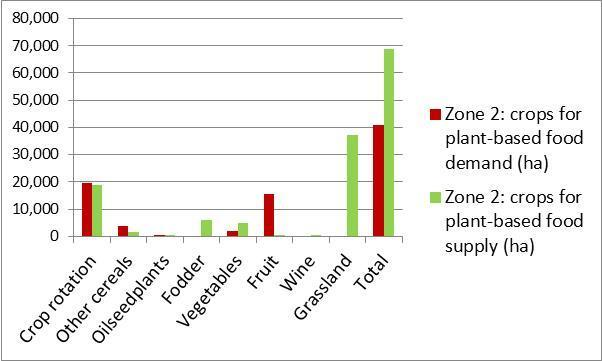Metropolitan Foodscape Planner Rotterdam City-Region
Zone 2 (Figure 2) is between 15 and 24 km distance from the centre and can be entirely dedicated to producing crops for plant-based food: all the consumption needs arising from the 1.2 million Rotterdam people can theoretically be satisfied within this zone. However, the current land use is still focusing strongly on livestock farming and that there are clear deficits fruit (15,000 ha missing) and slight deficits for rotation crops, other cereals and oilseed plants. Certainly when comparing to other European metropoles, the major surplus for vegetables (more than 3000 ha) is exceptional. This can be explained with the presence of the extensive areas of Dutch glasshouse production in Westland and Oostland (see Figure 1). Today this production is dedicated to 90% for food export and is strongly dominated by a few lead crops such as tomatoes, zucchini and bell paprika.

Zone 3 (Figure 3) follows between 24 and 40 km distance from the city centre. According to our scheme, this zone is entirely dedicated to crops supporting the city’s demand for livestock such as dairy and meat products. Given the resource intensity of animal-based food products it is not surprising that this zone requires a surface area four times as large than the one for plant-based food products in Zone 2: more than 160,000 ha. In this zone the largest deficit is for fodder crops (almost 100,000 ha). Today these fodder crops are being imported from more remote Dutch locations and of course in the form of soya feedstuff from oversee amounting to about 20% of the total (van Gelder and Herder 2012). On the other hand we see a clear surplus of grassland production for dairy farming. In terms of the zones diameter (16 km) it should be kept in mind that this is also a consequence of the city’s location close to the North Sea where no land-based food production is possible.


Zone 4 (Figure 4) spans over a distance from 40 km to 150 km measures from the city centre. This means that the Transition zone spans well into Belgium and Germany. Applying the OECD scheme as a reference (7.8 million people) means, that such a region covers almost half of amount of the total Dutch population (16 million). Also here it is important to acknowledge the fact that the sea-side location of this region almost doubles the distance of the zone towards the inland. Even so, the large area demand in terms of local hectares (almost 1.4 million) demonstrates the realities of densely populated regions here and elsewhere in the world. In terms of the demand-supply relationship, the transition zone mirrors the situation of Zone 3: the biggest deficit is for fodder crops required for livestock farming.

The MFP out presented in figure 14 to 18 are not only meant as assessment results for framing the impact of urban food production on the different metropolitan zones, but are also providing operational input to a stakeholder-oriented foodscape-planning device. For this purpose we introduce the data into the so-called ‘digital maptable’ which allows users to perform land use allocations by means of a digital pen. Addressing the surplus/demand figures resulting from the assessment, users can than make proposals for where and how to change the existing land use (food crops) in order to more properly meet the demands identified by the tool. (Please see for further illustrations of the maptable approach Wascher et al. 2015).
